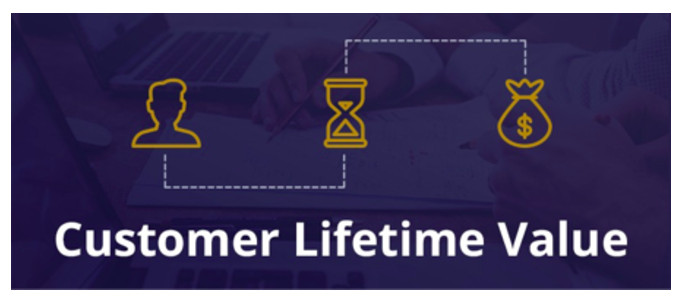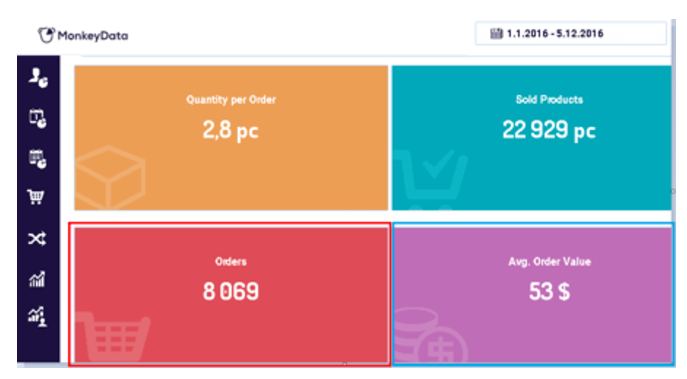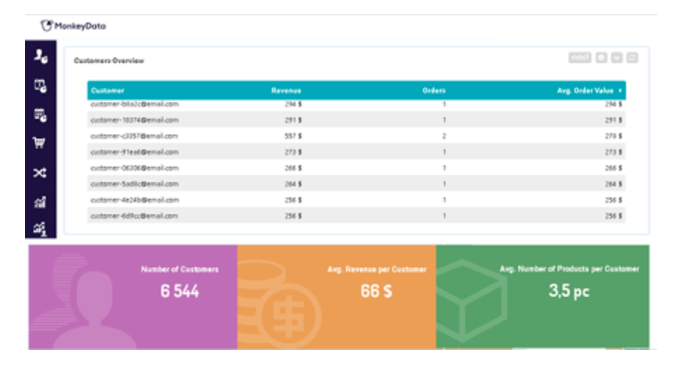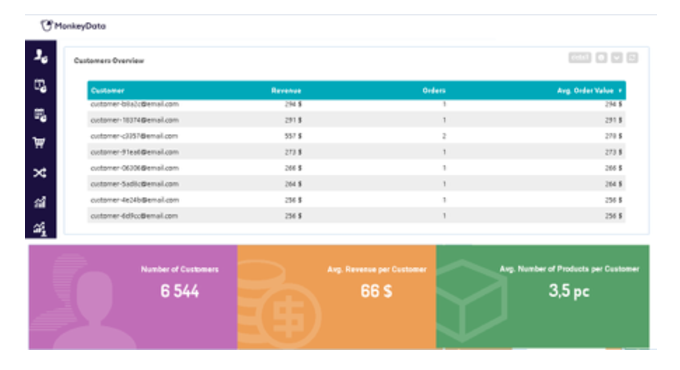The golden metric for your online store – customer lifetime value
Written by
Editorial TeamPublished on

You’re all quite busy now, right? Of course, it’s peak season for ecommerce sales. But this dynamic time brings you a unique opportunity to analyze your data and adjust your activities to get the most out of them. The holiday season should give you a wealth of data about the performance of your products and customers. Let’s use it! You can track them on your own or you can save your time by using some intelligent analytics tool to do it for you.
There are some crucial metrics you already know because you need to track them every day in order to maximize sales in your online store. You should know how many pieces were sold, your revenue, your best selling products and your conversion rate. Let’s take a look at a more complicated metric that will make or break your online store.
The Golden Metric
Let’s talk today about a different metric. A metric that helps a company become much more profitable by defining ideal customers – the ones that spend the most. For this reason it is often called “the golden metric.”
Customer Lifetime Value – CLV for short, or sometimes called just life-time value (LTV) is the total monetary value of a customer to a business over the entirety of their relationship. With a CLV calculation, you’re learning, in essence, what your average customer is “worth” to your company. However it is not only about one customer, but also about taking look at your customer base as whole – understanding that while some never return and some never leave, on average there is a typical customer lifetime and that lifetime has a specific economic value.

Why we should care about Customer Lifetime Value?
Because if you don’t know what a client is worth, you don’t know what you should spend to get one or what you should spend to keep one. It teaches you to understand the economic value of each customer and helps you to make smart decisions about your investments. For instance, if it costs you $100 to acquire a customer, and your customer’s CLV is $75, then you’ve got a problem.
Understanding this type of data helps a company become much more profitable and also helps to define the ideal customers for the marketing and sales team to focus on.
How to measure Customer Lifetime Value?
There are many extremely complex and difficult ways to measure CLV, with the use of statistics and mathematically challenging formula. But when you have the right input data, such as, for example, the data you get from MonkeyData, it is much easier.
To calculate your CLV, find the average order value by dividing total revenue by the number of orders. Then, estimate the frequency of the customer’s purchases by dividing the number of total orders by the number of unique customers over a given time period like a year. After that, calculate Customer value by multiplying customers’ average order value by their purchase frequency. And finally, when you multiple the Customer value by the average lifespan of your customer and you have the Customer lifetime value!
Discovering all these variables might be rather time consuming but using the right tools can help you save time for more pleasant things.
Open your MonkeyData app, select Online Store – Orders and get your Orders and Average Order Value in few seconds in one place.

Orders and Average Order Value (per specific period) are crucial metrics for defining customer lifetime value.
Then just change Orders for Customers and explore the their structure according to the visits.

New vs.returning customers.
Even using a basic calculation for CLV puts you ahead of your competition. You don’t need to make crazy mathematical calculations, just be aware of the value a customer provides over the course of their life. Being aware of your CLV allows you to make marketing decisions that drive long term success.
You may think that it’s insane to calculate the value of each customer, but you can use the same formula for calculating the CLV by segment. It’s great, useful and it allows you to see how profitable different types of customers are to your business.
Make proper customer segmentation with MonkeyData
MonkeyData allows you to see your customers from different points of view and thus to create the communication more personalized. In the section Online Store – Customers you can see detailed information about them.

Detailed information about your customers.


Customers are monitored by their Revenue, Orders and Average Order Value. Each of these metrics tells you about their purchasing behaviour. You can easily learn them and react with the right email communication.
For example, those with the highest revenue are not price sensitive, they do not mind paying for high-quality products. Send them the notification about your new collection and top-notch products.
Customers with the high amount of orders are likely to purchase more often. You can afford to send them offers more frequently. They may react positively to seasonal offers, discounts or product related to those they bought recently, for example, some sport or hobby equipment. They may also be interested in subscribing to some packages to use and invest further, such as https://www.bullionboxsubscriptions.com/
High average order value means two things. Either they buy fewer; but more expensive products or vice versa – more things for less money. These customers might be sensitive to free shipping, discounts, coupons or offering related products.
You can try more options and learn what works the best to extend and increase their lifetime value.

Analyzing data makes sense. Guess, what your customers need and suggest them products from your store.
Tips and tricks to improve your Customer Lifetime Value
Mathematically speaking, there are three basic things you have to do to boost your Customer Lifetime Value. First, encourage your customers to spend more on each order. Second, keep your customers coming back more often. Third, prolong your average customer lifespan. Sounds logical, but how can we do this?
Tactics to increase your average order value include:
– Adding a discount or free shipping when a customer reaches a certain pricing threshold. It’s always good to set this slightly above your current average order value so that people spend a little bit more. For example, if your average order value is $75, you can set free shipping or a 10% discount at $90, to encourage to spend a little bit more.
– Upselling and cross-selling: suggest complementary products that people may want with their product. For example, if you are selling cameras, you may want to suggest that your customer buys the appropriate camera case as well. Upselling in the camera example would be offering a slightly better version of the current camera before the customer makes the purchase, thus encouraging them to spend a bit more.
– Also, provide volume discounts to encourage customers to buy larger volumes of your product. If you can provide customers a good deal, they will be more incensed to make a larger order.
In terms of keeping customers coming back to your store, there are many tactics that you can employ, for example:
– Use seasonal discounts to keep them coming back. These are topical and give people a good reason to shop. Use these discounts around Valentine’s Day, Halloween, Christmas, etc.
– Put together a creative email campaign or contest for your customers to get them engaged during special occasions.
To increase your customer lifespan, one of the most important things is building long-term relationships. While it may take a little extra time, care and consideration, it’s a great way to increase revenues from existing customers without simultaneously increasing your expenses. It is a bit more high level and strategic than just using tactics to encourage people to purchase frequently. It is said that loyal customers buy 90% more frequently and spend 60% more per transaction.

Everybody wants to invest into good relationships that last.
How to build long-term relationships?
– Create brand loyalty – there are three major determining factors of brand loyalty – the quality of products, customer service and ‘shared values’. Customers will keep returning if you’re offering consistently high quality products and exceptional customer service. As for shared values – you need to choose a philosophy which reflects your consumers’ beliefs and demonstrate them through sponsorship, events or any other ways you can think of. Be sure to brand all marketing efforts consistently, so consumers keep returning to what’s comfortable and familiar.
– Have excellent customer service – there should be an overwhelming commitment to having exceptional customer service within your organization. Outstanding customer service is the foundation of any e-Commerce business, and will have a significant impact on your relationships with customers. If you want to discover more about top-notch customer service, this is a great article.
– Employees who stand behind your products – Employees should be seen like the most loyal of all your customers. If your employees promote your product, it is more likely that customers will view the product favorably and make a purchase.
Building long-term relationships is a very complicated and lengthy process, but it is worth it in the end. Remember, if you want to create a long-term relationship you have to be honest and do everything in the best interests of your customers.
Having a clear idea of your CLV will help provide meaningful insights into how you can plan future marketing campaigns and improve future customer interactions. Customer lifetime value is a powerful tool and a very important marketing metric that can give you a strong indication of your company’s health in the long-term.
You should implement your data tracking into your company’s routine. Setting up the calculations and checking in on your CLV by customer segment will help you to ensure that all your marketing efforts are profitable.
If you are interested in learning more about different metrics and indicators you can always tune in to the MonkeyRadio channel.
Happy analyzing!


